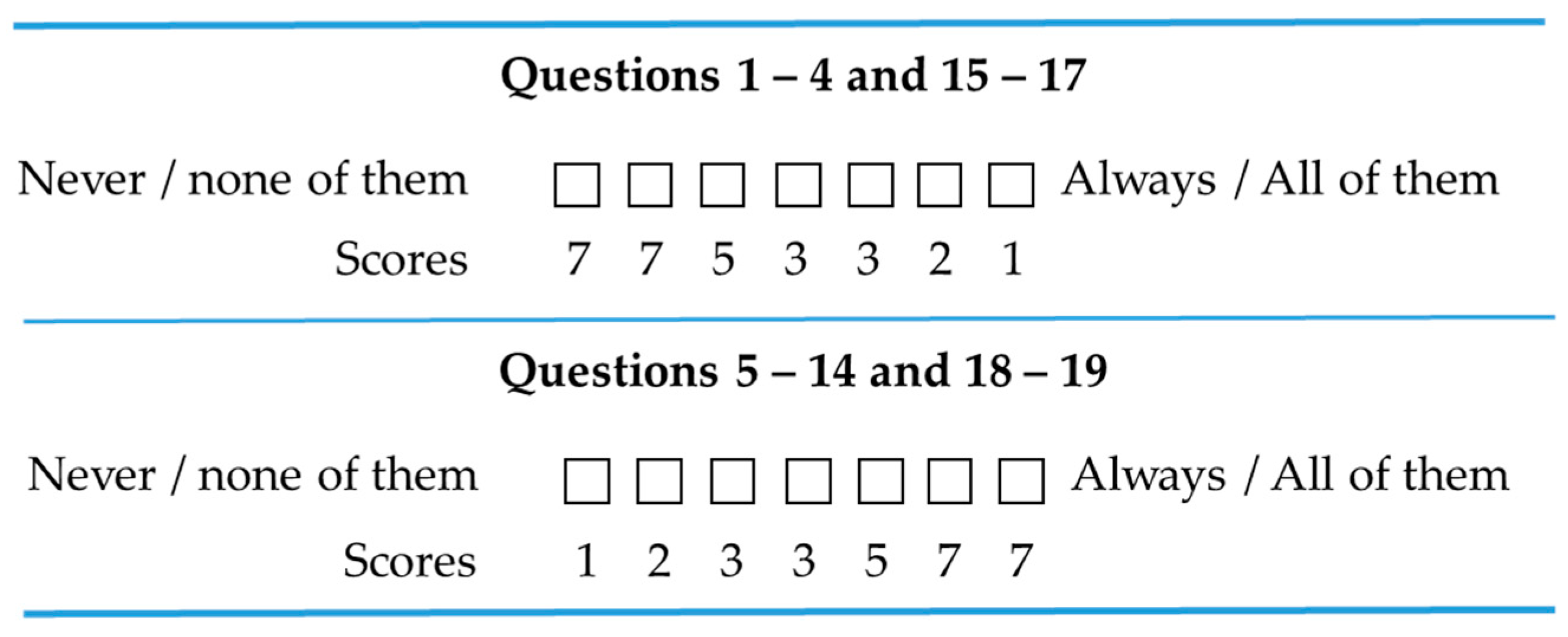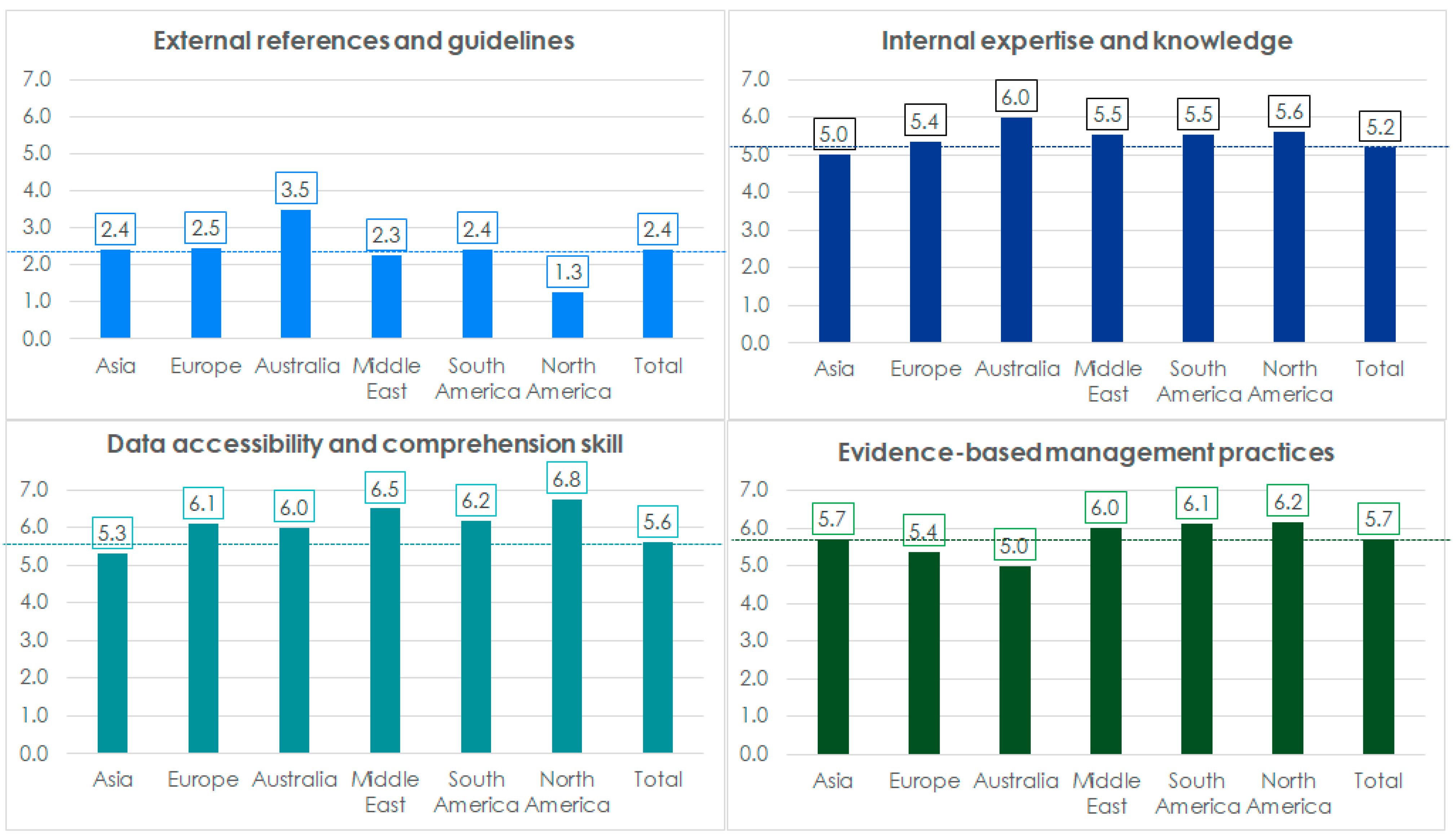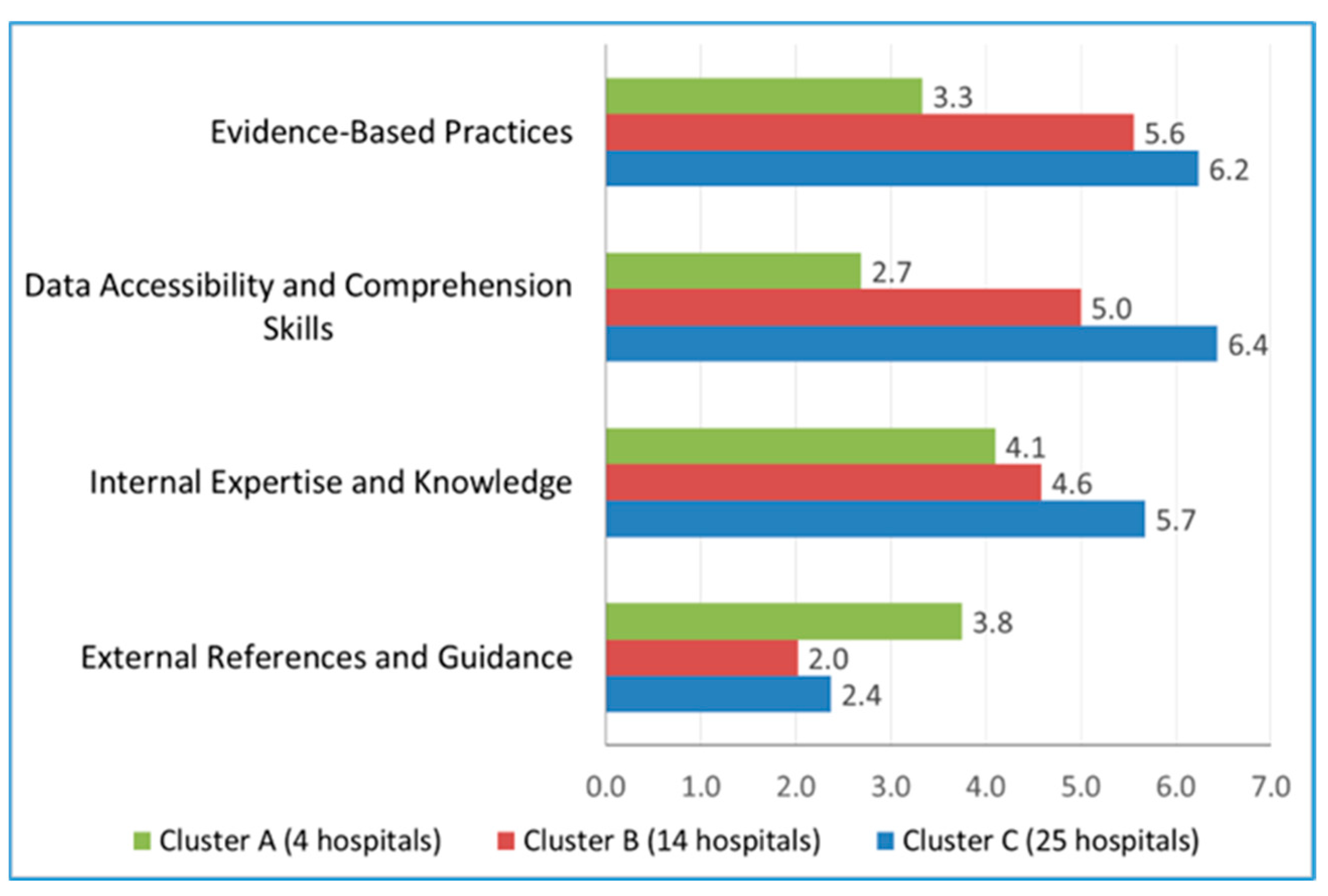Evaluating the Adoption of Evidence-Based Management Practices in Eye Hospitals
Abstract
1. Introduction
2. Methodology
2.1. Participants
2.2. Sampling Method and Sample Size
2.3. Survey Questionnaire
2.4. Data Collection
2.5. Validation and Reliability of the Questionnaire
2.6. Survey Administration
2.6.1. Survey of LAICO Cohort of Hospitals
2.6.2. Survey of WAEH Cohort of Hospitals
2.7. Classification of Questions
- I.
- External References and Guidance: This group includes four questions designed to assess the extent to which organizational decisions are influenced by external inputs. These influences include practices such as fostering innovation through external insights, benchmarking to identify and adopt best practices from other organizations, emulating strategies followed by peer institutions, and consulting external experts or advisors.
- II.
- Internal Expertise and Knowledge: Comprising five questions, this category evaluates the involvement of internal experts and stakeholders in the decision-making process, reflecting the organization’s reliance on in-house knowledge.
- III.
- Data Accessibility and Comprehension Skills: Focused on the organization’s ability to handle data effectively, this category includes four questions relating to accessing, understanding, and using internal data for decision-making.
- IV.
- Evidence-Based Practices: The largest category, consisting of six questions, examines the presence of processes and practices that promote evidence-based management within the organization.
2.8. Scoring of Responses
2.9. Statistical Analysis
3. Results
3.1. Geographic Distribution of Participants
3.2. Evidence-Based Practices
3.3. Thematic Focuses of Management Practices Across Regions
3.4. Associations Among Thematic Categories of Management Practices
3.5. Associations of Thematic Focuses of Management Practice with Hospital Clusters
3.6. Practices That Support and Undermine Alignment with EBM Principles
4. Discussion
5. Conclusions
Supplementary Materials
Author Contributions
Funding
Institutional Review Board Statement
Informed Consent Statement
Data Availability Statement
Conflicts of Interest
References
- Martini, C. What “Evidence” in Evidence-Based Medicine? Topoi 2021, 40, 299–305. [Google Scholar] [CrossRef]
- Lehane, E.; Leahy-Warren, P.; O’Riordan, C.; Savage, E.; Drennan, J.; O’Tuathaigh, C.; O’Connor, M.; Corrigan, M.; Burke, F.; Hayes, M.; et al. Evidence-based practice education for healthcare professions: An expert view. BMJ Evid.-Based Med. 2019, 24, 103–108. [Google Scholar] [CrossRef] [PubMed]
- Parand, A.; Dopson, S.; Renz, A.; Vincent, C. The role of hospital managers in quality and patient safety: A systematic review. BMJ Open 2014, 4, e005055. [Google Scholar] [CrossRef] [PubMed]
- Bohmer, R.M.J.; Pisano, G.P.; Sadun, R.; Tsai, T.C. How Hospitals Can Manage Supply Chain Shortages as Demand Surges. Harvard Business Review. 3 April 2020. Available online: https://www.hbs.edu/faculty/Pages/item.aspx?num=58185 (accessed on 12 December 2024).
- Guo, R.; Berkshire, S.D.; Fulton, L.; Hermanson, P. Using an Evidence-Based Management Approach in Healthcare Administration Decision-Making. Acad. Manag. Proc. 2017, 30, 330–342. [Google Scholar] [CrossRef]
- Shafaghat, T.; Imani Nasab, M.H.; Bahrami, M.A.; Kavosi, Z.; Roozrokh Arshadi Montazer, M.; Rahimi Zarchi, M.K.; Bastani, P. A mapping of facilitators and barriers to evidence-based management in health systems: A scoping review study. Syst. Rev. 2021, 10, 42. [Google Scholar] [CrossRef]
- Humphries, S.; Stafinski, T.; Mumtaz, Z.; Menon, D. Barriers and facilitators to evidence-use in program management: A systematic review of the literature. BMC Health Serv. Res. 2014, 14, 171. [Google Scholar] [CrossRef]
- Jessani, N.; Kennedy, C.; Bennett, S. Enhancing evidence-informed decision making: Strategies for engagement between public health faculty and policymakers in Kenya. Evid. Policy 2017, 13, 225–253. [Google Scholar] [CrossRef]
- Janati, A.; Hasanpoor, E.; Hajebrahimi, S.; Sadeghi-Bazargani, H.; Khezri, A. An Evidence-Based Framework for Evidence-Based Management in Healthcare Organizations: A Delphi Study. Ethiop. J. Health Sci. 2018, 28, 305–314. [Google Scholar] [CrossRef]
- Liang, Z.; Howard, P.; Rasa, J. Evidence-Informed Managerial Decision- Making: What evidence counts? (Part One). Asia Pac. J. Health Manag. 2011, 6, 23–29. [Google Scholar]
- Subburaman, G.B.; Munavalli, J.R.; Ravilla, T.; Mertens, H.; Webers, C.; Rao, S.V.; Van Merode, F. Managing Outpatient Cycle Times in Hospitals Using Integrated Closed-Loop Approaches. Health Serv. Insights 2023, 16, 11786329221145858. [Google Scholar] [CrossRef]
- Sutton, R.T. An overview of clinical decision support systems: Benefits, risks, and strategies for success. Npj Digit. Med. 2020, 3, 17. [Google Scholar] [CrossRef] [PubMed]
- Balu, B.S.; Gupta, S.; Ravilla, R.D.; Ravilla, T.D.; Mertens, H.; Webers, C.; Rao, S.V. Impact of practicing internal benchmarking on continuous improvement of cataract surgery outcomes: A retrospective observational study at Aravind Eye Hospitals, India. BMJ Open 2023, 13, e071860. [Google Scholar] [CrossRef] [PubMed]
- Weiner, J. Integrating Strategic and Operational Decision Making Using Data-Driven Dashboards: The Case of St. Joseph Mercy Oakland Hospital. J. Healthcare Manag. 2015, 60, 319–330. [Google Scholar] [CrossRef]
- Rabiei, R.; Almasi, S. Requirements and challenges of hospital dashboards: A systematic literature review. BMC Med. Inform. Decis. Mak. 2022, 22, 287. [Google Scholar] [CrossRef]
- Crisan, E.L.; Mihaila, A. Health-care information systems adoption—A review of management practices. Vilakshan-XIMB J. Manag. 2023, 20, 130–139. [Google Scholar] [CrossRef]
- Saleh, A.; Teneiji, A.; Yahia, T.; Salim, A.; Riaz, Z. International Journal of Medical Informatics Factors impacting the adoption of big data in healthcare: A systematic literature review. Int. J. Med. Inform. 2024, 187, 105460. [Google Scholar] [CrossRef]
- Bilkstyte-Skane, D.; Akstinaite, V. Strategic organizational changes: Adopting data—Driven decisions. Strateg. Change 2024, 33, 107–116. [Google Scholar] [CrossRef]
- Shahbaz, M.; Gao, C.; Zhai, L.; Shahzad, F.; Hu, Y. Investigating the adoption of big data analytics in healthcare: The moderating role of resistance to change. J. Big Data 2019, 6, 6. [Google Scholar] [CrossRef]
- Freitas, A.T. Data-Driven Approaches in Healthcare: Challenges and Emerging Trends. In Multidisciplinary Perspectives on Artificial Intelligence and the Law; Freitas, A.T., Sousa Antunes, H., Freitas, P.M., Oliveira, A.L., Martins Pereira, C., Vaz de Sequeira, E., Barreto Xavier, L., Eds.; Springer: Berlin/Heidelberg, Germany, 2023; pp. 65–80. ISBN 9783031412646. [Google Scholar]
- Na, A.; Torchi-Tardy, E.T.; Levif, M.; Michel, P. Benchmarking: A Method for Continuous Quality Improvement in Health Le benchmarking: Une méthode d’ amélioration continue de la qualité en santé. Health Policy 2012, 7, e101–e119. [Google Scholar]
- Goncharuk, A.G.; Lazareva, N.O.; Alsharf, I.A. Benchmarking as a performance management method. Polish J. Manag. Stud. 2016, 11, 27–36. [Google Scholar]
- Centre for Evidence-Based Management. EBM Self-Assessment For Organizations. 2021. Available online: https://cebma.org/assets/Uploads/EBM-Assessment-Quiz-vs-Aug-2021.pdf (accessed on 12 December 2024).
- Pfeffer, J.; Sutton, R.I. Evidence-Based Management. Harv. Bus. Rev. 2006, 84, 62–74. [Google Scholar] [PubMed]
- Rousseau, D.M. Is there such a thing as “evidence-based management”? Acad. Manag. Rev. 2006, 31, 256–269. [Google Scholar] [CrossRef]
- Baird, L.M.G.; Miller, T.; Edward, P.; Island, P.E. Factors influencing for community nurses. J. Community Nurs. 2015, 20, 233–242. [Google Scholar] [CrossRef] [PubMed]
- Edmondson, A.C. Strategies for Learning from Failure. Harv. Bus. Rev. 2011, 89, 48–55. [Google Scholar]
- Science, D. Bias and the Perils of Benchmarking The Blinding Light of Success. Harv. Bus. Rev. 2005, 83, 114–119. [Google Scholar]
- Kaplan, R.S. When Benchmarks Do Not Work. Harvard Business School—Working Knowledge. 2006. Available online: https://hbswk.hbs.edu/item/when-benchmarks-dont-work (accessed on 5 April 2021).



| Regions n, Row % | Not Evidence-Based | Sometimes Compatible with Principles of EBM | Committed and Consistent with Principles of EBM | Total |
|---|---|---|---|---|
| Asia | 1 | 17 | 11 | 29 |
| 3.5% | 58.6% | 37.9% | 100% | |
| Australia | 0 | 0 | 1 | 1 |
| 0.0% | 0.0% | 100.0% | 100% | |
| Europe | 0 | 3 | 2 | 5 |
| 0.0% | 60.0% | 40.0% | 100% | |
| Middle East | 0 | 1 | 2 | 3 |
| 0.0% | 33.3% | 66.7% | 100% | |
| North America | 0 | 1 | 1 | 2 |
| 0.0% | 50.0% | 50.0% | 100% | |
| South America | 0 | 1 | 2 | 3 |
| 0.0% | 33.3% | 66.7% | 100% | |
| Total | 1 | 23 | 19 | 43 |
| 2.3% | 53.5% | 44.2% | 100% |
| Variables Co-Efficient and p-Value | Evidence-Based Practices | Use of External References and Guidelines | Use of Internal Expertise | Data Access and Comprehension Skills |
|---|---|---|---|---|
| Evidence-based practices | 1.00 | −0.38 (0.01) | 0.48 (0.00) | 0.69 (0.00) |
| Use of external references and guidelines | −0.38 (0.01) | 1.00 | −0.23 (0.13) | −0.36 (0.02) |
| Use of internal expertise | 0.48 (0.00) | −0.23 (0.13) | 1.00 | 0.37 (0.02) |
| Data access and comprehension skills | 0.69 (0.00) | −0.36 (0.02) | 0.37 (0.02) | 1.00 |
| Thematic Group | Questions | Scores (Number of Responses Shown in Table) | Group | |||||
|---|---|---|---|---|---|---|---|---|
| 1 | 2 | 3 | 5 | 7 | % Who Scored 1, 2 or 3 | % Who Scored 5 or 7 | ||
| ER | My organization believes it is important to adopt new and innovative practices. | 29 | 11 | 3 | 0 | 0 | 100% | 0% |
| ER | My organization uses benchmarking to identify best practices used in other organizations. | 15 | 14 | 11 | 1 | 2 | 93% | 7% |
| ER | My organization makes decisions by looking at what other organizations are doing. | 11 | 5 | 21 | 3 | 3 | 86% | 14% |
| ER | My organization uses consultants to help us make decisions. | 6 | 8 | 21 | 3 | 5 | 81% | 19% |
| IE | Managers in my organization tend to believe that the organization is unique and hence the outcome of scientific research is not applicable. | 1 | 6 | 15 | 6 | 15 | 51% | 49% |
| IE | Managers and senior staff in my organization tend to believe that experience and knowledge gained on the job is the only important source of information when considering how to tackle a problem. | 4 | 7 | 11 | 7 | 14 | 51% | 49% |
| IE | Internal politics and power struggles influence the way my organization makes decisions about policies and practices. | 2 | 10 | 7 | 6 | 18 | 44% | 56% |
| EB | We follow a systematic improvement process to address the problems and work on improvements. e.g., Lean six sigma, IHI (Institute of Health Improvement), TPM, TQM model etc. | 3 | 1 | 12 | 13 | 14 | 37% | 63% |
| DA | Managers in my organisation know how to appraise the trustworthiness of the findings from scientific research. | 3 | 4 | 7 | 13 | 16 | 33% | 67% |
| EB | Before any (strategic/tactical/important) decision is taken, my organisation consults the scientific literature to verify claims regarding assumed problems or effective solutions. | 0 | 0 | 10 | 12 | 21 | 23% | 77% |
| EB | Our organisation systematically evaluates the effectiveness of new policies and practices before we introduce. | 1 | 1 | 8 | 10 | 23 | 23% | 77% |
| EB | Before we implement new policies or practices we obtain a baseline against which subsequent evaluation can be compared. | 0 | 2 | 7 | 9 | 25 | 21% | 79% |
| DA | Managers and senior staff in my organisation know how to use the Internet to search for scientific evidence to guide their decisions. | 1 | 2 | 5 | 12 | 23 | 19% | 81% |
| IE | Before any (strategic/operational/routine/tactical) decision is taken, we consult the most important stakeholders (people inside or outside the organisation who may be affected by the decision) to verify claims regarding assumed problems or effective solutions. | 0 | 0 | 6 | 5 | 32 | 14% | 86% |
| DA | Managers and senior staff in my organisation have access to appropriate information systems that contain People Data (e.g., absenteeism, turnover, job satisfaction), Patients Data (Number of patients served, Number of complaints, Patients’ satisfaction) and overall Business Performance Data (e.g., productivity data, financial indicators) | 0 | 0 | 6 | 9 | 28 | 14% | 86% |
| DA | Managers and staff in my organisation know how to critically assess the quality of organisational/internal data. | 0 | 1 | 4 | 10 | 28 | 12% | 88% |
| IE | Before any (strategic/operational/routine/tactical) decision is taken we consult experienced professionals within our organisation to verify claims regarding assumed problems or effective solutions. | 0 | 1 | 3 | 7 | 32 | 9% | 91% |
| EB | Before any (strategic/operational/routine/tactical) decision is taken, we systematically evaluate internal data to better understand the nature of the problem | 0 | 1 | 3 | 5 | 34 | 9% | 91% |
| EB | If we make mistakes in our decision-making we try to learn from them. | 0 | 0 | 2 | 4 | 37 | 5% | 95% |
Disclaimer/Publisher’s Note: The statements, opinions and data contained in all publications are solely those of the individual author(s) and contributor(s) and not of MDPI and/or the editor(s). MDPI and/or the editor(s) disclaim responsibility for any injury to people or property resulting from any ideas, methods, instructions or products referred to in the content. |
© 2025 by the authors. Licensee MDPI, Basel, Switzerland. This article is an open access article distributed under the terms and conditions of the Creative Commons Attribution (CC BY) license (https://creativecommons.org/licenses/by/4.0/).
Share and Cite
Subburaman, G.-B.B.; Gupta, S.; Ravilla, T.; Mertens, H.; Webers, C.A.B.; Biggelaar, F.J.H.M.v.d.; Zuilen, M.v.; Sundar, B.; Merode, F.v. Evaluating the Adoption of Evidence-Based Management Practices in Eye Hospitals. Healthcare 2025, 13, 222. https://doi.org/10.3390/healthcare13030222
Subburaman G-BB, Gupta S, Ravilla T, Mertens H, Webers CAB, Biggelaar FJHMvd, Zuilen Mv, Sundar B, Merode Fv. Evaluating the Adoption of Evidence-Based Management Practices in Eye Hospitals. Healthcare. 2025; 13(3):222. https://doi.org/10.3390/healthcare13030222
Chicago/Turabian StyleSubburaman, Ganesh-Babu B., Sachin Gupta, Thulasiraj Ravilla, Helen Mertens, Carroll A.B. Webers, Frank J.H.M. van den Biggelaar, Maaike van Zuilen, Balagiri Sundar, and Frits van Merode. 2025. "Evaluating the Adoption of Evidence-Based Management Practices in Eye Hospitals" Healthcare 13, no. 3: 222. https://doi.org/10.3390/healthcare13030222
APA StyleSubburaman, G.-B. B., Gupta, S., Ravilla, T., Mertens, H., Webers, C. A. B., Biggelaar, F. J. H. M. v. d., Zuilen, M. v., Sundar, B., & Merode, F. v. (2025). Evaluating the Adoption of Evidence-Based Management Practices in Eye Hospitals. Healthcare, 13(3), 222. https://doi.org/10.3390/healthcare13030222







